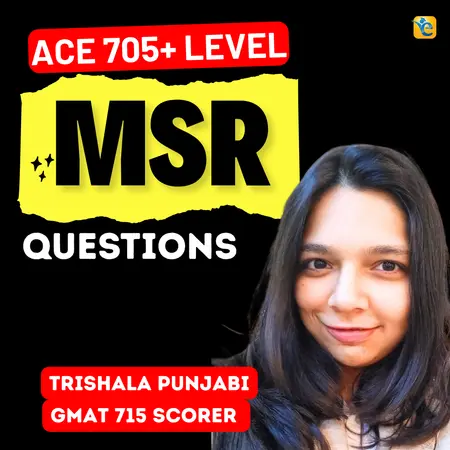Events & Promotions
|
|

GMAT Club Daily Prep
Thank you for using the timer - this advanced tool can estimate your performance and suggest more practice questions. We have subscribed you to Daily Prep Questions via email.
Customized
for You
Track
Your Progress
Practice
Pays
Not interested in getting valuable practice questions and articles delivered to your email? No problem, unsubscribe here.
- Nov 19
12:30 PM EST
-01:30 PM EST
Learn how Keshav, a Chartered Accountant, scored an impressive 705 on GMAT in just 30 days with GMATWhiz's expert guidance. In this video, he shares preparation tips and strategies that worked for him, including the mock, time management, and more - Nov 20
01:30 PM EST
-02:30 PM IST
Learn how Kamakshi achieved a GMAT 675 with an impressive 96th %ile in Data Insights. Discover the unique methods and exam strategies that helped her excel in DI along with other sections for a balanced and high score. - Nov 22
11:00 AM IST
-01:00 PM IST
Do RC/MSR passages scare you? e-GMAT is conducting a masterclass to help you learn – Learn effective reading strategies Tackle difficult RC & MSR with confidence Excel in timed test environment - Nov 23
11:00 AM IST
-01:00 PM IST
Attend this free GMAT Algebra Webinar and learn how to master the most challenging Inequalities and Absolute Value problems with ease. - Nov 24
07:00 PM PST
-08:00 PM PST
Full-length FE mock with insightful analytics, weakness diagnosis, and video explanations! - Nov 25
10:00 AM EST
-11:00 AM EST
Prefer video-based learning? The Target Test Prep OnDemand course is a one-of-a-kind video masterclass featuring 400 hours of lecture-style teaching by Scott Woodbury-Stewart, founder of Target Test Prep and one of the most accomplished GMAT instructors.
Kudos
Bookmarks
D
Be sure to select an answer first to save it in the Error Log before revealing the correct answer (OA)!
Difficulty:
 15%
(low)
15%
(low)
Question Stats:
78% (01:27) correct 22%
(01:33)
wrong
22%
(01:33)
wrong  based on 1981
sessions
based on 1981
sessions
History
Date
Time
Result
Not Attempted Yet
Quadrilateral RSTU shown above is a site plan for a parking lot in which side RU is parallel to side ST and RU is longer than ST. What is the area of the parking lot?
(1) RU = 80 meters
(2) TU = \(20\sqrt{10}\) meters
Attachment:
lot.png [ 7.64 KiB | Viewed 32245 times ]
Kudos
Bookmarks
Quadrilateral RSTU shown above is a site plan for a parking lot in which side RU is parallel to side ST and RU is longer than ST. What is the area of the parking lot?
Given figure is a trapezoid, thus its area is SW*(ST+RU)/2=60*(45+RU)/2. So, all we need to know to answer the question is the length of RU.
(1) RU = 80 meters. Sufficient.
(2) TU = \(20\sqrt{10}\) meters. Draw altitude from vertex T to RU as shown below:
Since TX=SW=60 and TU = \(20\sqrt{10}\), then we can find XU. Therefore we can find RU=RW+WX+XU. Sufficient.
Answer: D.
Attachment:
trapezoid.png [ 12.4 KiB | Viewed 30300 times ]
General Discussion
Kudos
Bookmarks
Bunuel
Hi Bunuel,
I am referring to a similar question in Sackmann's Challenge sets (as attached). At first it seemed a simple and a straightforward option D, but the solution (in spoiler) provided in the set says we do not know about the symmetry and hence we cannot use pythagoras theorem to deduce the base of the triangle. I am not sure if this reasoning is correct. Please advise.
Statement (1) is insufficient, but it does help. Knowing ST, combined with
the given length, allows us to use the pythagorean theorem to and the length
of SW. However, that does not give us the entire length of RS unless we knew
the figure was symmetrical, which we dont.
the given length, allows us to use the pythagorean theorem to and the length
of SW. However, that does not give us the entire length of RS unless we knew
the figure was symmetrical, which we dont.
Thanks.
Attachments
File comment: Similar Question
Need clarity.PNG [ 33.38 KiB | Viewed 21561 times ]














